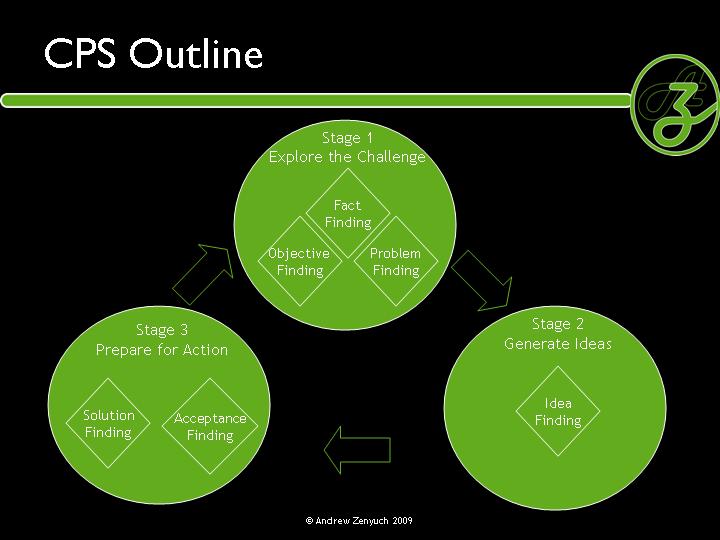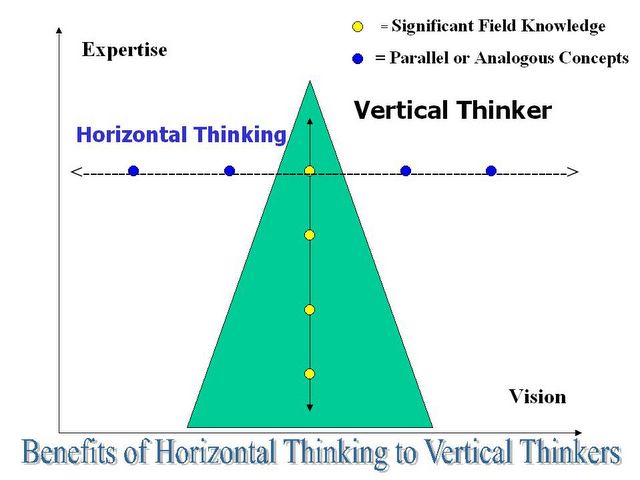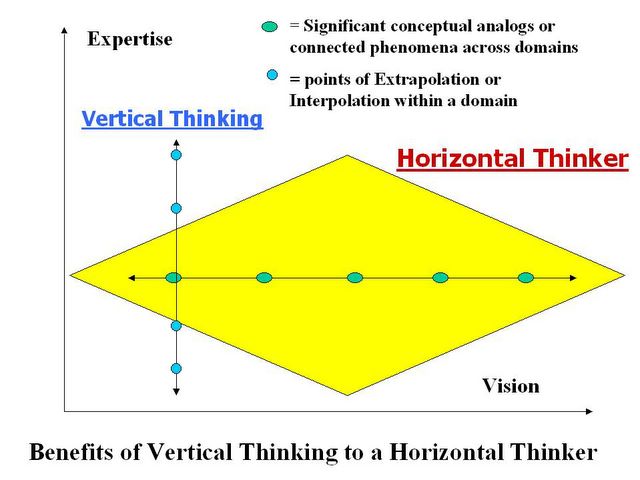Cognitive Tools for Creative Thinking
[by Mark Safranski, a.k.a “zen“]

It has been some time since I have touched upon this topic. Recently though, I initiated a discussion at work on ways to enhance and stimulate creativity and creative thinking and presented a suite of methods for generating and refining ideas. I didn’t get into the insight-based aspects of creativity, nor the high-level kinds of synthesis you see with people who have genuine mastery over a field or domain. My focus was more on developing people’s ability to think divergently, generate or recognize novel ideas and then refine or develop them.
Therefore, many of these are active, intentional exercises or strategies. They tend to be productive but their creativity is not quite the same as what is produced, say, when a skilled musician is “jamming”, an inventor is tinkering or a painter or scientist is experimenting in the “flow“. The following are also not an exhaustive list:
Creative Problem Solving (CPS)
Developed by Alex Osborn and Sidney Parnes, CPS seeks to harness Divergent and Convergent thinking in a holistic, multi-step, learning process. In essence, the students are sequentially alternating between Generating ideas and Focusing on refining, evaluating, applying them until the “problem” is solved. This is one of the older models of instilling creative thinking and has been widely used, particularly for well-defined or technical problems.

Edward DeBono Lateral Thinking Exercises
DeBono developed a system of forced choice and association exercises that are well suited to promoting critical and creative thinking at the same time as students address a concept or activity. Lateral Thinking exercises lend themselves naturally to being made into graphic organizers or as leading questions in class or group discussion. Some examples:
PMI – “Plus, Minus, Interesting” OPV – “Other People’s Views
ADI – “Agreement, Disagreement, Irrelevant” APC – “Alternatives, Possibilities, Choices”
EBS – “Examine Both Sides” CAF – “Consider All Factors”
HVLV – “High Value, Low Value” AGO – “Aims, Goals, Objectives”
TEC – “Target, Explore, Conclude” PISCO – “Purpose, Input, Solutions, Choice”
Related to Lateral Thinking, but not the same, is Horizontal Thinking. While the former are concrete exercises, horizontal thinking is using a familiar area of knowledge to look for analogies and patterns in less or unfamiliar fields. Both Lateral and Horizontal thinking differ from the traditional model of analytical-reductionist Vertical Thinking associated with critical thinking done within a subject matter field. Vertical thinking and Lateral/Horizontal thinking complement one another


Variations on “Brainstorming”
We all have used brainstorming. There are some ways to make brainstorming more productive.
Ideational Pools – Ask a series of open-ended questions to a group that creates a much richer, single “pool” of ideas than simple brainstorming
Uses, Instances, Similarities – this is usually about a physical object and the purpose is to generate as many alternatives as possible – i.e. “How many different uses can you think of for a piece of rope?”. It is both divergent and lateral thinking as an activity.
Synectics – Extends brainstorming by taking the results and developing metaphors, similes, metonymy/synedoche that describe/explain them
Group Roles (or stages) –
- Generator: Comes up with ideas
- Conceptualizer: Organizes, categorizes, renames ideas
- Optimizer: Refines ideas with a view to action – the “How”
- Implementor Takes action
Morphological Synthesis
Morphological synthesis works through decomposition and forced association, There are several variations but it works best with well-defined problems. Examples.
- Define the problem or identify a thing. List all of the attributes.
- Combine and re-configure attributes in new ways
or
- Divide problem into parts
- Develop a solution for each part
- Combine solutions
Critical Question Mapping
A system of fast learning, developed by friend of ZP Dr. Terry Barnhart, discovers the “what” of a situation by having everyone brainstorm all of the critical questions that must be answered to find a solution. No declarative statements may be made, only questions asked. After the group has exhausted the potential questions, the questions can be organized into clusters, a learning strategy, divided for research, etc.
Scenario Exercises
The use of imaginative but realistic premises for a thought experiment and discussion. Popular in the fields of futurism, alternative history and physics, they allow the students to explore reasons behind making decisions, constructing hypothetical, framing problems or as an allegorical experience before exploring the real situation or problem. Scenarios come in different forms and draw on both critical and creative thinking:
Counterfactual: Ex- “What if the South won the Civil War?”
Futurist: Ex- Imagine a world entering a new ice age – how would Illinois ecosystems be impacted by the climate change?”
Physical: Ex- “Schrodinger’s Cat”
Paradoxical: Ex – “Could a man travel through time and kill his own grandfather? Could you drown in the fountain of eternal life?”
Doublequotes
Juxtaposing opposing or incompatible authoritative views to encourage synthesis or reflective choice. This is a favorite technique of Charles Cameron in his Hipbone method of analysis that he employs regularly here at ZP.
Moral Reasoning
Like Scenarios, moral reasoning and ethical dilemmas push people to think both creatively and critically. Example:
“A madman who has threatened to explode several bombs in crowded areas has been apprehended. Unfortunately, he has already planted the bombs and they are scheduled to go off in a short time. It is possible that hundreds of people may die. The authorities cannot make him divulge the location of the bombs by conventional methods. He refuses to say anything and requests a lawyer to protect his fifth amendment right against self-incrimination. In exasperation, some high level official suggests torture. This would be illegal, of course, but the official thinks that it is nevertheless the right thing to do in this desperate situation. Do you agree?”
Many ethical dilemmas and student solutions can be analyzed according to Kohlberg’s Stages of Moral Development but the value for creative thinking is in creating the conditions of a forced choice requiring a resolution.

What techniques do you use for creativity?



May 16th, 2015 at 11:17 pm
“What techniques do you use for creativity?”
You mean the un-insightful kind?
It depends a lot on where the problem is coming from. I mean, if it is not broken, why fix it?
In other words, why get creative if everything is in harmony? It is only when something isn’t in harmony that I get interested. Two out-of-harmony questions takes two equations to answer, and if they are related, you might be looking at a Blackswan. So I get interested.
Question one: why is line-2’s crane slower than line one’s, when they are mirror images of each other?
Question two: why did the bull-gear on line-2’s crane wear outside manufacturer’s tolerances, when the manufacture (Yale hoists) says it never happens? (Note 1: It should be noted that, from what I observed, if the bull-gear was to wearout, whatever the crane was lifting at the time, a potential 10+ tons of ugly, would free-fall, bypassing all safeties, from a potential height of approximately 35 feet).
When I suggested there was a connection to my supervisor he literally ran out into the office hallway crying that the crane may fall down. Luck would have it, we met the department head of production in the hallway.
Such a drama queen. A drama queen who also took at least one tour of duty in Vietnam. More duty that I ever care to have.
Short story: nobody died because of the Black Swan I was observing, but the problem of the crane being slower on line-2 than on line-1 did get fixed. So the first equation was solved.
As someone online recently seemed to suggest: vectors are more important than positions, here are the vectors.
Vector one, culturally, the slow crane was thought to be no problem, as explained by my supervisor. The fact that line-2’s crane was slow did not upset the workflow.
Vector 2: I, as a shift mechanic, observed line-2 crane for nearly 2 years and couldn’t find any structural thing wrong. It was only after the crane took on a falling “position” (structure, culture, position), where the bull-gear could fail, that it connected for me. And then it was several months after my supervisor told me what the manufacturer findings were that I could put it all together.
Vector 3: See note one.
Death brings reality home and reality is not all that it is cracked up to be.
If you were not talking Blackswans and I am really off-topic, please disregard this comment all together.